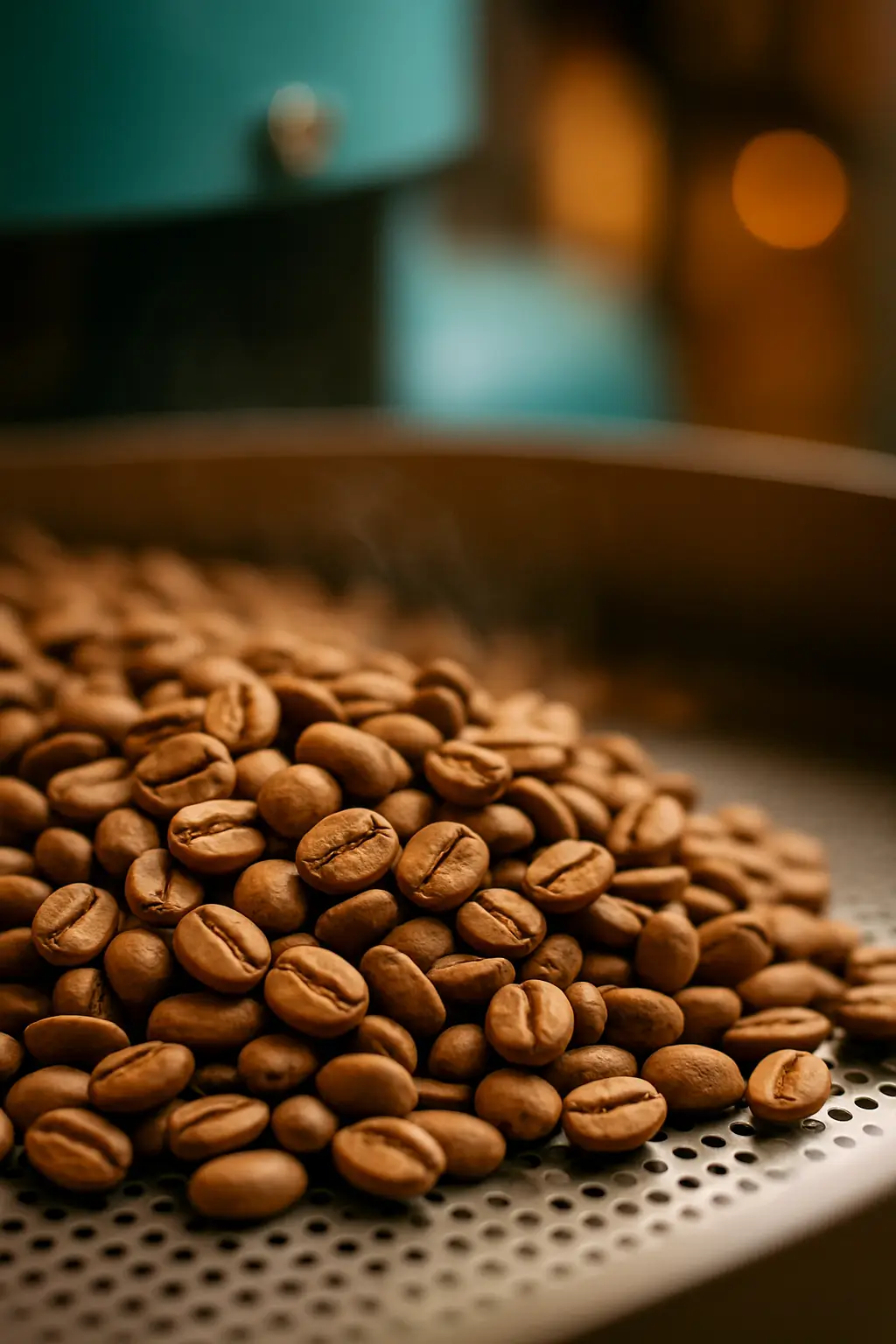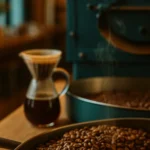The coffee world truly gives us an incredible range of flavors and aromas, all shaped by how we roast the beans. When you understand different roast levels, you start to appreciate the unique qualities each coffee bean offers. So, what about light roast coffee? It’s a popular choice in specialty coffee because it really highlights the bean’s natural character.
- What defines light roast coffee?
- What makes the flavor profile of light roast coffee so unique?
- Light Roast vs. Dark Roast: Key Differences in Roasting & Flavor
- What about the caffeine in light roast coffee? Let’s debunk some myths.
- What are the best coffee beans for light roasting?
- How can you brew light roast coffee for optimal flavor?
- The Bright World of Light Roast Coffee
Light roast coffee is all about a bright, origin-forward roast. It’s designed to bring out the unique subtleties of where the bean came from. We’ll look at its specific traits, its lively flavor, and how it differs from darker roasts. You’ll also learn about its caffeine content, the best beans for this roast, and the brewing methods you need to unlock its full potential.
What defines light roast coffee?
Light roast coffee gets its unique physical traits and flavor because it undergoes minimal heat during roasting. This roasting style aims to keep the coffee bean’s inherent qualities intact, rather than adding flavors from the roast itself. It looks and tastes quite different from medium or dark roast coffee.
What color and appearance do light roast coffee beans have?
Light roast coffee beans are usually pale to medium brown. They are noticeably lighter than their medium or dark roasted cousins. This light brown color tells you the roasting time was shorter; the beans haven’t yet developed those deep caramelized hues. You won’t see that dark, almost black look you get with other beans—that’s a clear visual cue.
What is the surface texture of light roast coffee?
Light roast coffee beans feel dry and oil-free on the surface, which is a key characteristic. This dry surface happens because we stop the roasting process before the bean’s internal oils can move to the outside. Darker roasts, in contrast, often have an oily sheen because the roasting goes on much longer.
What are the roast temperature and “First Crack” for light roast coffee?
For light roasts, we typically roast the beans until their internal temperature reaches about 356°F to 401°F (180°C to 205°C). Roasters stop the process right after the “first crack” sound. This sound means the bean is expanding and going through its initial chemical changes. Stopping early ensures we keep those delicate origin flavors, preventing them from being overshadowed by roast-derived notes. You can learn more about the complete coffee roasting process for a deeper understanding.
What makes the flavor profile of light roast coffee so unique?
Light roast coffee offers a flavor profile known for its vibrancy, complexity, and how it really highlights the bean’s origin. It gives you a sensory experience very different from darker roasts, showcasing the coffee bean’s actual inherent taste. This approach emphasizes natural acidity, delicate notes, and a lighter body.
How bright is the acidity in light roast coffee?
Light roast coffee is famous for its high, bright, crisp acidity. It tastes vibrant, never harsh. This lively acidity elevates the whole cup, much like the refreshing tartness you find in fruits. Many coffee lovers compare this acidity to citrus or fresh berries.
What floral and fruity notes can you find in light roast coffee?
You’ll discover delicate floral and fruity notes in light roast coffee. This is a direct result of the shorter roasting time. Less caramelization means these notes stay intact, preserving the natural sugars and volatile compounds. You might taste:
- Bright citrus
- Sweet berries (like blueberry, strawberry, or raspberry)
- Juicy stone fruits (such as peach, apricot, or plum)
- Sometimes subtle herbal or jasmine undertones
What about the body and aroma of light roast coffee?
Light roast coffee usually has a light-bodied mouthfeel; people often describe it as clean and tea-like. This lighter body helps create its refreshing character. Its aroma is fresh, fragrant, and clearly reflects its origin. For example, Kenyan varieties might give you blackcurrant notes, while Ethiopian coffee beans often have jasmine-like aromas.
Light Roast vs. Dark Roast: Key Differences in Roasting & Flavor
To really grasp the difference between light roast and dark roast coffees, we need to look at their unique roasting processes and how they transform flavor. Medium roast coffee also serves as an important point of comparison in this range, showing us how the coffee bean changes progressively. These differences profoundly impact the final taste in your cup.
How do roasting process and stages differ between light and dark roasts?
The roasting process for light roast coffee uses significantly lower temperatures and shorter durations compared to darker roasts. We typically pull light roasts from the roaster at or just after the “first crack”—that distinct popping sound the beans make as they expand. Medium roast coffee, on the other hand, continues roasting until around the “second crack.” Dark roast coffee goes even further, often well beyond the second crack, which is why you see oil on the bean surface. The Maillard Reaction, which creates complex flavors, develops far less in light roasts, preserving more of the bean’s original characteristics.
How do acidity and body evolve across light and dark roasts?
Acidity gradually decreases the longer you roast. So, light roast coffee keeps a much higher, brighter acidity and a distinct light-bodied profile. As the roast deepens, medium roasts develop a more balanced acidity, while darker roasts feature much lower acidity, giving way to a fuller body and more pronounced bitterness. The chemical compounds responsible for acidity simply don’t degrade as much in lighter roasts.
How does flavor transform from light to dark roast coffee?
Light roasts preserve more of the coffee bean’s natural flavors and prominent origin characteristics because there’s minimal chemical transformation. You taste the bean’s intrinsic qualities, often revealing delicate floral, fruity, or herbal notes. Dark roast coffee, however, develops more roast-driven characteristics, like chocolatey, smoky, nutty, and sometimes even charcoal notes, as roasting caramelizes sugars and breaks down natural acids. This fundamental difference explains why choosing a roast level is so important for experiencing different facets of coffee.
Here is a table summarizing the key differences:
| Characteristic | Light Roast Coffee | Medium Roast Coffee | Dark Roast Coffee |
|---|---|---|---|
| Roast Level | Lightest | Medium | Darkest |
| Internal Temperature | 356°F to 401°F | 410°F to 428°F | 437°F to 482°F |
| Cracking Stage | Just after First Crack | Around Second Crack | Beyond Second Crack |
| Bean Appearance | Light brown, dry | Medium brown, slightly oily | Dark brown/black, oily surface |
| Acidity | High, bright, crisp | Balanced | Low, bitter |
| Body | Light, tea-like | Medium | Full |
| Flavor Emphasis | Origin characteristics, floral, fruity | Balanced, sweet, caramel | Roast-driven, smoky, chocolatey |
What about the caffeine in light roast coffee? Let’s debunk some myths.
People often think light roast coffee has much more caffeine than darker roasts. But the truth about caffeine content is actually more complex. Caffeine is incredibly heat-stable, meaning the roasting process doesn’t significantly break it down.
How much caffeine is in a single coffee bean for light roast?
A single coffee bean holds roughly the same amount of caffeine, no matter how light or dark it’s roasted. Roasting mainly reduces the bean’s mass by removing water and other volatile compounds; it doesn’t destroy the caffeine itself. So, the actual caffeine in each individual bean stays pretty consistent.
Does light roast coffee have more caffeine by weight or by volume?
The perceived difference in caffeine between light roast coffee and darker roasts often depends on how you measure it. By weight (say, in grams), dark roast coffee might actually contain slightly more caffeine. This happens because darker roasted beans are lighter and less dense due to greater moisture loss, meaning you can fit more beans into the same measured weight. Conversely, when you measure by volume (like by scoops), light roast coffee may have slightly more caffeine.
Light roast beans are denser and keep more of their mass, so a scoop of light roast coffee will physically contain more coffee material, and therefore, more caffeine. Darker roasts *may* also allow for a slightly higher caffeine extraction into your brewed cup—up to 95% compared to 92% for light roasts—which can also influence the final caffeine level in your mug.
Here’s a quick summary:
| Measurement Method | Caffeine Content (Relative) | Reason |
|---|---|---|
| Per Single Bean | About Equal | Caffeine is heat stable and does not degrade significantly during roasting. |
| By Weight (grams) | Dark Roast > Light Roast | Darker beans are lighter (less dense), so more beans (and caffeine) fit per gram. |
| By Volume (scoops) | Light Roast > Dark Roast | Light roast beans are denser, so more coffee mass (and caffeine) fits per scoop. |
What are the best coffee beans for light roasting?
Certain coffee bean origins really shine when you light roast them. These beans have delicate and complex flavors that truly emerge with a lighter roast, allowing their authentic origin profile to come through. Picking the right beans is absolutely crucial for an exceptional light roast.
Which Ethiopian and Central American beans are best for light roast coffee?
Ethiopian coffee beans are perfect for light roasting; we celebrate them for their bright, fruity, and floral flavors. Light roasting enhances and preserves their complex, delicate characteristics, often giving you notes of jasmine, blueberry, or citrus. Central American coffee beans, known for their light body, sharp acidity, and subtle fruit notes, also flourish under a light roast. This method lets you fully appreciate their distinct regional profiles.
Which South American and Hawaiian beans are ideal for light roast coffee?
South American coffee beans, like those from Costa Rica, are excellent for light roasting. They give you bright, smooth, and often floral notes that might even include hints of chocolate. Hawaiian Kona coffee beans also benefit from light roasting because of their mild, fruity, and delicate flavors. Light roasting stops their subtle qualities from being overwhelmed by the intense caramelization that happens with darker roasts.
Why do certain origins shine in light roast coffee?
Light roasting perfectly suits beans that naturally have complex, bright, and delicate flavors. This method allows their nuanced, origin-driven profiles to vividly emerge, emphasizing the coffee’s unique terroir. These beans contain special compounds that create their distinct flavors, which would be lost with prolonged roasting. This preservation of the original coffee bean’s natural flavors offers a clear contrast to roasts that emphasize more roast-driven notes like chocolate or smoke. For an in-depth look at different bean types, explore our Ethiopian coffee guide.
How can you brew light roast coffee for optimal flavor?
Brewing light roast coffee correctly is essential to truly bring out its unique qualities and vibrant flavor profile. These beans are denser and less soluble, so you’ll need to make specific adjustments to your brewing method to get the best extraction. Paying attention to key variables ensures you’ll get a delicious cup.
Why is water temperature so important for brewing light roast coffee?
Using hotter water is crucial for light roast coffee. Ideally, aim for temperatures between 195°F and 212°F, with specific recommendations often hovering around 203°F to 205°F (95°C to 96°C). Light roast beans are denser and less soluble than darker roasts, meaning they need more energy from hotter water for effective extraction. This hotter water helps dissolve and extract those delicate acids and complex flavors locked within the less porous beans.
What is the ideal grind size and extraction time for light roast coffee?
You should use a finer grind size for light roast coffee than you would for darker roasts. A finer grind increases the surface area of the coffee particles, allowing for more efficient and faster extraction from those denser light roast beans. Also, plan for a slightly longer extraction time. For instance, aim for 3–4 minutes for a pour-over method or 4–5 minutes for a French press. This extended contact time helps fully develop the intricate flavors without introducing bitterness.
What are the recommended brewing methods for light roast coffee?
Several brewing methods truly excel at extracting optimal flavor from light roast coffee:
- Pour-over methods: Think Hario V60, Chemex, or Kalita Wave. These are highly recommended because they allow for controlled, slow extraction.
- French Press: This can also be effective, as long as you carefully control water temperature and immersion time.
- AeroPress: A great choice for its precise extraction capabilities.
- Siphon: Another method known for its precision.
Always pay close attention to careful pouring and agitation techniques to ensure you get uniform extraction. For more detailed instructions, consider reviewing a dedicated pour-over brewing guide.
The Bright World of Light Roast Coffee
When you understand what light roast coffee is all about, you discover a world of bright, vibrant, and complex flavors that truly celebrate the coffee bean’s origin. This roasting style stands out with its light brown, dry beans, high acidity, and rich floral and fruity notes, all preserved thanks to a shorter roasting process. To really appreciate its unique qualities, you need to optimize your brewing parameters—that means using hotter water, a finer grind, and longer extraction times.
Light roast coffee truly appeals to those who want to experience the authentic, nuanced natural flavors of the original coffee bean, rather than characteristics that come from the roasting itself.









